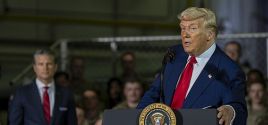Cops With Machine Guns: How the War on Terror Has Militarized the PoliceOver the past 10 years, law enforcement officials have begun to look and act more and more like soldiers. Here's why we should be alarmed.By Arthur Rizer and Joseph Hartman The Atlantic Nov. 08, 2011 |
Popular 
Report: Hamas Says Witkoff Promised to Lift Gaza Blockade in Exchange for Edan Alexander

Eloy Adrian Camarillo, 17, Arrested in Shooting Death of Infowars Reporter Jamie White

Ben Shapiro, Mark Levin and Laura Loomer Warn of Foreign Influence... From Qatar

NYT: Trump Ended War With Houthis After They Shot Down U.S. Drones, Nearly Hit Fighter Jets

'If Iran Abandons Its Nuclear Program, Will Israel Do The Same?': Israeli Spox Launches Into Tirade Over Pointed Question
 At around 9:00 a.m. on May 5, 2011, officers with the Pima County, Arizona, Sheriff's Department's Special Weapons and Tactics (S.W.A.T.) team surrounded the home of 26-year-old José Guerena, a former U.S. Marine and veteran of two tours of duty in Iraq, to serve a search warrant for narcotics. As the officers approached, Guerena lay sleeping in his bedroom after working the graveyard shift at a local mine. When his wife Vanessa woke him up, screaming that she had seen a man outside the window pointing a gun at her, Guerena grabbed his AR-15 rifle, instructed Vanessa to hide in the closet with their four-year old son, and left the bedroom to investigate. Within moments, and without Guerena firing a shot--or even switching his rifle off of "safety"--he lay dying, his body riddled with 60 bullets. A subsequent investigation revealed that the initial shot that prompted the S.W.A.T. team barrage came from a S.W.A.T. team gun, not Guerena's. Guerena, reports later revealed, had no criminal record, and no narcotics were found at his home. Sadly, the Guerenas are not alone; in recent years we have witnessed a proliferation in incidents of excessive, military-style force by police S.W.A.T. teams, which often make national headlines due to their sheer brutality. Why has it become routine for police departments to deploy black-garbed, body-armored S.W.A.T. teams for routine domestic police work? The answer to this question requires a closer examination of post-9/11 U.S. foreign policy and the War on Terror. Ever since September 14, 2001, when President Bush declared war on terrorism, there has been a crucial, yet often unrecognized, shift in United States policy. Before 9/11, law enforcement possessed the primary responsibility for combating terrorism in the United States. Today, the military is at the tip of the anti-terrorism spear. This shift appears to be permanent: in 2006, the White House's National Strategy for Combating Terrorism confidently announced that the United States had "broken old orthodoxies that once confined our counterterrorism efforts primarily to the criminal justice domain." Read More |



